Understanding Long-Term Variations in Surface Ozone in United States (U.S.) National Parks
Abstract
:1. Introduction
2. Data and Methods
3. Results
3.1. The Multidecadal Trend
3.2. The Seasonal Cycle
3.2.1. Change in Amplitude of Seasonal Cycles
3.2.2. Change in Timing of Seasonal Cycles
3.3. Variability by Large-Scale Climate Circulation Linked to Components C9 and C10
4. Discussion
4.1. Impacts of Domestic Emissions Reductions on Rural Ozone Trends
4.2. Variability in the Seasonal Cycle of U.S. Surface Ozone
4.3. Effects of Large-Scale Climate Circulation on Seasonal Cycles of U.S. Surface Ozone
4.4. Increasing Annual 4th-Highest DM8HA and Annual Amplitude of Ozone at DENA-HQ over 1987–2015
5. Conclusions
Acknowledgments
Author Contributions
Conflicts of Interest
References
- US Environmental Protection Agency. National Ambient Air Quality Standard for Ozone; Final Rule-2015; US Environmental Protection Agency: Washington, DC, USA, 2015; Volume 80.
- US Environmental Protection Agency. National Ambient Air Quality Standards for Ozone; Final Rule-2008; US Environmental Protection Agency: Washington, DC, USA, 2008; Volume 73.
- Simon, H.; Reff, A.; Wells, B.; Xing, J.; Frank, N. Ozone trends across the United States over a period of decreasing NOx and VOC emissions. Environ. Sci. Technol. 2015, 49, 186–195. [Google Scholar] [CrossRef] [PubMed]
- Parrish, D.D.; Law, K.S.; Staehelin, J.; Derwent, R.; Cooper, O.R.; Tanimoto, H.; Volz-Thomas, A.; Gilge, S.; Scheel, H.-E.; Steinbacher, M.; et al. Long-term changes in lower tropospheric baseline ozone concentrations at northern mid-latitudes. Atmos. Chem. Phys. 2012, 12, 11485–11504. [Google Scholar] [CrossRef] [Green Version]
- Jacob, D.J.; Logan, J.A.; Murti, P.P. Effect of rising Asian emissions on surface ozone in the United States. Geophys. Res. Lett. 1999, 26, 2175–2178. [Google Scholar] [CrossRef]
- Lin, M.; Fiore, A.M.; Horowitz, L.W.; Langford, A.O.; Oltmans, S.J.; Tarasick, D.; Rieder, H.E. Climate variability modulates western US ozone air quality in spring via deep stratospheric intrusions. Nat. Commun. 2015, 6, 7105–7116. [Google Scholar] [CrossRef] [PubMed]
- Lin, M.; Horowitz, L.W.; Payton, R.; Fiore, A.M.; Tonnesen, G. US surface ozone trends and extremes from 1980 to 2014: Quantifying the roles of rising Asian emissions, domestic controls, wildfires, and climate. Atmos. Chem. Phys. 2017, 17, 2943–2970. [Google Scholar] [CrossRef]
- Lin, M.; Horowitz, L.W.; Oltmans, S.J.; Fiore, A.M.; Fan, S. Tropospheric ozone trends at Mauna Loa Observatory tied to decadal climate variability. Nat. Geosci. 2014, 7, 136–143. [Google Scholar] [CrossRef]
- Cooper, O.R.; Gao, R.S.; Tarasick, D.; Leblanc, T.; Sweeney, C. Long-term ozone trends at rural ozone monitoring sites across the United States, 1990–2010. J. Geophys. Res. Atmos. 2012, 117, D22307. [Google Scholar] [CrossRef]
- Oman, L.D.; Ziemke, J.R.; Douglass, A.R.; Waugh, D.W.; Lang, C.; Rodriguez, J.M.; Nielsen, J.E. The response of tropical tropospheric ozone to ENSO. Geophys. Res. Lett. 2011, 38, L13706. [Google Scholar] [CrossRef]
- Fiore, A.M.; Naik, V.; Leibensperger, E.M. Air Quality and Climate Connections. J. Air Waste Manage. Assoc. 2015, 65, 645–685. [Google Scholar] [CrossRef] [PubMed]
- Parrish, D.D.; Petropavlovskikh, I.; Oltmans, S.J. Reversal of Long-Term Trend in Baseline Ozone Concentrations at the North American West Coast. Geophys. Res. Lett. 2017, 44, 10675–10681. [Google Scholar] [CrossRef]
- Zhang, L.; Jacob, D.J.; Boersma, K.F.; Jaffe, D.A.; Olson, J.R.; Bowman, K.W.; Worden, J.R.; Thompson, A.M.; Avery, M.A.; Cohen, R.C.; et al. Transpacific transport of ozone pollution and the effect of recent Asian emission increases on air quality in North America: An integrated analysis using satellite, aircraft, ozonesonde, and surface observations. Atmos. Chem. Phys. Discuss. 2008, 8, 8143–8191. [Google Scholar] [CrossRef]
- Lin, M.; Fiore, A.M.; Horowitz, L.W.; Cooper, O.R.; Naik, V.; Holloway, J.; Johnson, B.J.; Middlebrook, A.M.; Oltmans, S.J.; Pollack, I.B.; et al. Transport of Asian ozone pollution into surface air over the western United States in Spring. J. Geophys. Res. Atmos. 2012, 117, D00V07. [Google Scholar] [CrossRef]
- Ziemke, J.R. La Niña and El Niño—Induced variabilities of ozone in the tropical lower atmosphere during 1970–2001. Geophys. Res. Lett. 2003, 30, 1142. [Google Scholar] [CrossRef]
- Langford, A.O.; Masterst, C.D. Modulation of Middle and upper tropospheric ozone at Northern midlatitudes by the El Niño Southern Oscillation. J. Geophys. Res. 1998, 25, 2667–2670. [Google Scholar] [CrossRef]
- Koumoutsaris, S.; Bey, I.; Generoso, S.; Thouret, V. Influence of El Niño-Southern Oscillation on the interannual variability of tropospheric ozone in the northern midlatitudes. J. Geophys. Res. Atmos. 2008, 113, D19301. [Google Scholar] [CrossRef]
- Parrish, D.D.; Law, K.S.; Staehelin, J.; Derwent, R.; Cooper, O.R.; Tanimoto, H.; Volz-Thomas, A.; Gilge, S.; Scheel, H.-E.; Steinbacher, M.; et al. Lower tropospheric ozone at northern midlatitudes: Changing seasonal cycle. Geophys. Res. Lett. 2013, 40, 1631–1636. [Google Scholar] [CrossRef]
- Carslaw, D.C. On the changing seasonal cycles and trends of ozone at Mace Head, Ireland. Atmos. Chem. Phys. Discuss. 2005, 5, 5987–6011. [Google Scholar] [CrossRef]
- Bloomer, B.J.; Vinnikov, K.Y.; Dickerson, R.R. Changes in seasonal and diurnal cycles of ozone and temperature in the eastern U.S. Atmos. Environ. 2010, 44, 2543–2551. [Google Scholar] [CrossRef]
- Monks, P.S. A review of the observations and origins of the spring ozone maximum. Atmos. Environ. 2000, 34, 3545–3561. [Google Scholar] [CrossRef]
- Wang, Y. Springtime photochemistry at northern mid and high latitudes. J. Geophys. Res. 2003, 108, 8358–8390. [Google Scholar] [CrossRef]
- Salisbury, G.; Monks, P.S.; Bauguitte, S.; Bandy, B.J.; Penkett, S.A. A Seasonal Comparison of the Ozone Photochemistry in Clean and Polluted Air Masses at Mace Head, Ireland. J. Atmos. Chem. 2002, 41, 163–187. [Google Scholar] [CrossRef]
- Cooper, O.R.; Parrish, D.D.; Stohl, A.; Trainer, M.; Nédélec, P.; Thouret, V.; Cammas, J.P.; Oltmans, S.J.; Johnson, B.J.; Tarasick, D.; et al. Increasing springtime ozone mixing ratios in the free troposphere over western North America. Nature 2010, 463, 344–348. [Google Scholar] [CrossRef] [PubMed]
- Jonson, J.E.; Simpson, D.; Fagerli, H.; Solberg, S. Can we explain the trends in European ozone levels? Atmos. Chem. Phys. 2006, 6, 51–66. [Google Scholar] [CrossRef]
- Cooper, O.R.; Parrish, D.D.; Ziemke, J.; Balashov, N.V.; Cupeiro, M.; Galbally, I.E.; Gilge, S.; Horowitz, L.; Jensen, N.R.; Lamarque, J.-F.; et al. Global distribution and trends of tropospheric ozone: An observation-based review. Elem. Sci. Anthr. 2014, 2. [Google Scholar] [CrossRef]
- Wu, Z.; Huang, N.E. Ensemble Empirical Mode Decomposition: A Noise Assisted Data Analysis Method. Adv. Adapt. Data Anal. 2009, 1, 385–388. [Google Scholar] [CrossRef]
- NPS Gaseous Pollutant and Met Data. Available online: https://ard-request.air-resource.com/ (accessed on 5 February 2018).
- National Park Service, Air Resources Division. Gaseous Pollutant Monitoring Program Quality Assurance Project Plan (QAPP); National Park Service, U.S. Department of the Interior: Denver, CO, USA, 2015.
- Wu, Z.; Huang, N.E.; Long, S.R.; Peng, C.-K. On the trend, detrending, and variability of nonlinear and nonstationary time series. Proc. Natl. Acad. Sci. USA 2007, 104, 14889–14894. [Google Scholar] [CrossRef] [PubMed]
- McDonald-Buller, E.C.; Allen, D.T.; Brown, N.; Jacob, D.J.; Jaffe, D.; Kolb, C.E.; Lefohn, A.S.; Oltmans, S.; Parrish, D.D.; Yarwood, G.; et al. Establishing Policy Relevant Background (PRB) Ozone Concentrations in the United States. Environ. Sci. Technol. 2011, 45, 9484–9497. [Google Scholar] [CrossRef] [PubMed]
- ECMWF. Advancing global NWP through international collaboration. Available online: https://www.ecmwf.int/ (accessed on 5 February 2018).
- Draxler, R.; Stunder, B.; Rolph, G.; Stein, A.; Taylor, A. HYSPLIT4 User’s Guide; NOAA Air Resources Laboratory: Silver Spring, MD, USA, 2016.
- Derwent, R.G.; Jenkin, M.E.; Saunders, S.M.; Pilling, M.J. Photochemical ozone creation potentials for organic compounds in northwest Europe calculated with a master chemical mechanism. Atmos. Environ. 1998, 32, 2429–2441. [Google Scholar] [CrossRef]
- Papineau, J.M. Wintertime temperature anomalies in Alaska correlated with ENSO and PDO. Int. J. Climatol. 2001, 21, 1577–1592. [Google Scholar] [CrossRef]
- Zhang, A.; Jia, G.; Epstein, H.E.; Xia, J. ENSO elicits opposing responses of semi-arid vegetation between Hemispheres. Sci. Rep. 2017, 7, 42281–42290. [Google Scholar] [CrossRef] [PubMed]
- Stuecker, M.F.; Timmermann, A.; Jin, F.-F.; McGregor, S.; Ren, H.-L. A combination mode of the annual cycle and the El Niño/Southern Oscillation. Nat. Geosci. 2013, 6, 540–544. [Google Scholar] [CrossRef]
- Newman, M.; Compo, G.P.; Alexander, M.A. ENSO-Forced Variability of the Pacific Decadal Oscillation. J. Clim. 2003, 16, 3853–3857. [Google Scholar] [CrossRef]
- Timmermann, A.; Latif, M.; Grötzner, A.; Voss, R. Modes of climate variability as simulated by a coupled general circulation model. Part I: ENSO-like climate variability and its low-frequency modulation. Clim. Dyn. 1999, 15, 605–618. [Google Scholar] [CrossRef]
- US Environmental Protection Agency. Air Pollutant Emissions Trends Data. Available online: https://www.epa.gov/air-emissions-inventories/air-pollutant-emissions-trends-data (accessed on 19 March 2018).
- Liu, Y.; Goodrick, S.; Heilman, W. Wildland fire emissions, carbon, and climate: Wildfire–climate interactions. For. Ecol. Manage. 2014, 317, 80–96. [Google Scholar] [CrossRef]
- Abatzoglou, J.T.; Williams, A.P. Impact of anthropogenic climate change on wildfire across western US forests. Proc. Natl. Acad. Sci. USA 2016, 113, 11770–11775. [Google Scholar] [CrossRef] [PubMed]
- Liu, J.C.; Mickley, L.J.; Sulprizio, M.P.; Dominici, F.; Yue, X.; Ebisu, K.; Anderson, G.B.; Khan, R.F.A.; Bravo, M.A.; Bell, M.L. Particulate air pollution from wildfires in the Western US under climate change. Clim. Change 2016, 138, 655–666. [Google Scholar] [CrossRef] [PubMed]
- Barbero, R.; Abatzoglou, J.T.; Larkin, N.K.; Kolden, C.A.; Stocks, B. Climate change presents increased potential for very large fires in the contiguous United States. Int. J. Wildl. Fire 2015, 24, 892–899. [Google Scholar] [CrossRef]
- Wilson, R.C.; Fleming, Z.L.; Monks, P.S.; Clain, G.; Henne, S.; Konovalov, I.B.; Szopa, S.; Menut, L. Have primary emission reduction measures reduced ozone across Europe? An analysis of European rural background ozone trends 1996–2005. Atmos. Chem. Phys. 2012, 12, 437–454. [Google Scholar] [CrossRef] [Green Version]
- Rodionov, S.N.; Bond, N.A.; Overland, J.E. The Aleutian Low, storm tracks, and winter climate variability in the Bering Sea. Deep Sea Res. Part II Top. Stud. Oceanogr. 2007, 54, 2560–2577. [Google Scholar] [CrossRef]
- Wilcox, L.J.; Highwood, E.J.; Dunstone, N.J. The influence of anthropogenic aerosol on multi-decadal variations of historical global climate. Environ. Res. Lett. 2013, 8, 24033–24042. [Google Scholar] [CrossRef]
- Lin, M.; Fiore, A.M.; Cooper, O.R.; Horowitz, L.W.; Langford, A.O.; Levy, H.; Johnson, B.J.; Naik, V.; Oltmans, S.J.; Senff, C.J. Springtime high surface ozone events over the western United States: Quantifying the role of stratospheric intrusions. J. Geophys. Res. Atmos. 2012, 117, D00V22. [Google Scholar] [CrossRef]
- L’Heureux, M.L. Atmospheric circulation influences on seasonal precipitation patterns in Alaska during the latter 20th century. J. Geophys. Res. 2004, 109, D06106. [Google Scholar] [CrossRef]
- Stein, K.; Timmermann, A.; Schneider, N.; Jin, F.F.; Stuecker, M.F. ENSO seasonal synchronization theory. J. Clim. 2014, 27, 5285–5310. [Google Scholar] [CrossRef]
- NOAA. ESRL Physical Sciences Division Pacific Decadal Oscillation Index. Available online: https://www.esrl.noaa.gov/psd/gcos_wgsp/Timeseries/PDO/ (accessed on 5 September 2017).
- Dentener, F.; Keating, T.; Akimoto, H. Hemispheric Transport of 2010 Part A: Ozone and Particulate Matter; United Nations Publication: Geneva, Switzerland, 2010; ISBN 978-92-1-117043-6. [Google Scholar]
- Jaffe, D.; Anderson, T.; Covert, D.; Kotchenruther, R.; Trost, B.; Danielson, J.; Simpson, W.; Berntsen, T.; Karlsdottir, S.; Blake, D.; et al. Transport of Asian air pollution to North America. Geophys. Res. Lett. 1999, 26, 711–714. [Google Scholar] [CrossRef]
- Berntsen, T.K.; Karlsdóttir, S.; Jaffe, D.A. Influence of Asian emissions on the composition of air reaching the north western United States. Geophys. Res. Lett. 1999, 26, 2171–2174. [Google Scholar] [CrossRef]
- Yienger, J.J.; Galanter, M.; Holloway, T.A.; Phadnis, M.J.; Guttikunda, S.K.; Carmichael, G.R.; Moxim, W.J.; Levy, H. The episodic nature of air pollution transport from Asia to North America. J. Geophys. Res. Atmos. 2000, 105, 26931–26945. [Google Scholar] [CrossRef]
- Yienger, J.; Carmichael, G.; Phadnis, M.; Guttikunda, S.; Holloway, T.; Galanter, M.; Moxim, W.; Levy, H., II. Transport of Air Pollution From Asia To North America. Air Pollut. Model. Its Appl. XIV 2001, 307–313. [Google Scholar]
- Holzer, M.; Hall, T.M.; Stull, R.B. Seasonality and weather-driven variability of transpacific transport. J. Geophys. Res. 2005, 110, D23103. [Google Scholar] [CrossRef]
- Bond, N.A.; Harrison, D.E. ENSO’s effect on Alaska during opposite phases of the Arctic Oscillation. Int. J. Climatol. 2006, 26, 1821–1841. [Google Scholar] [CrossRef]

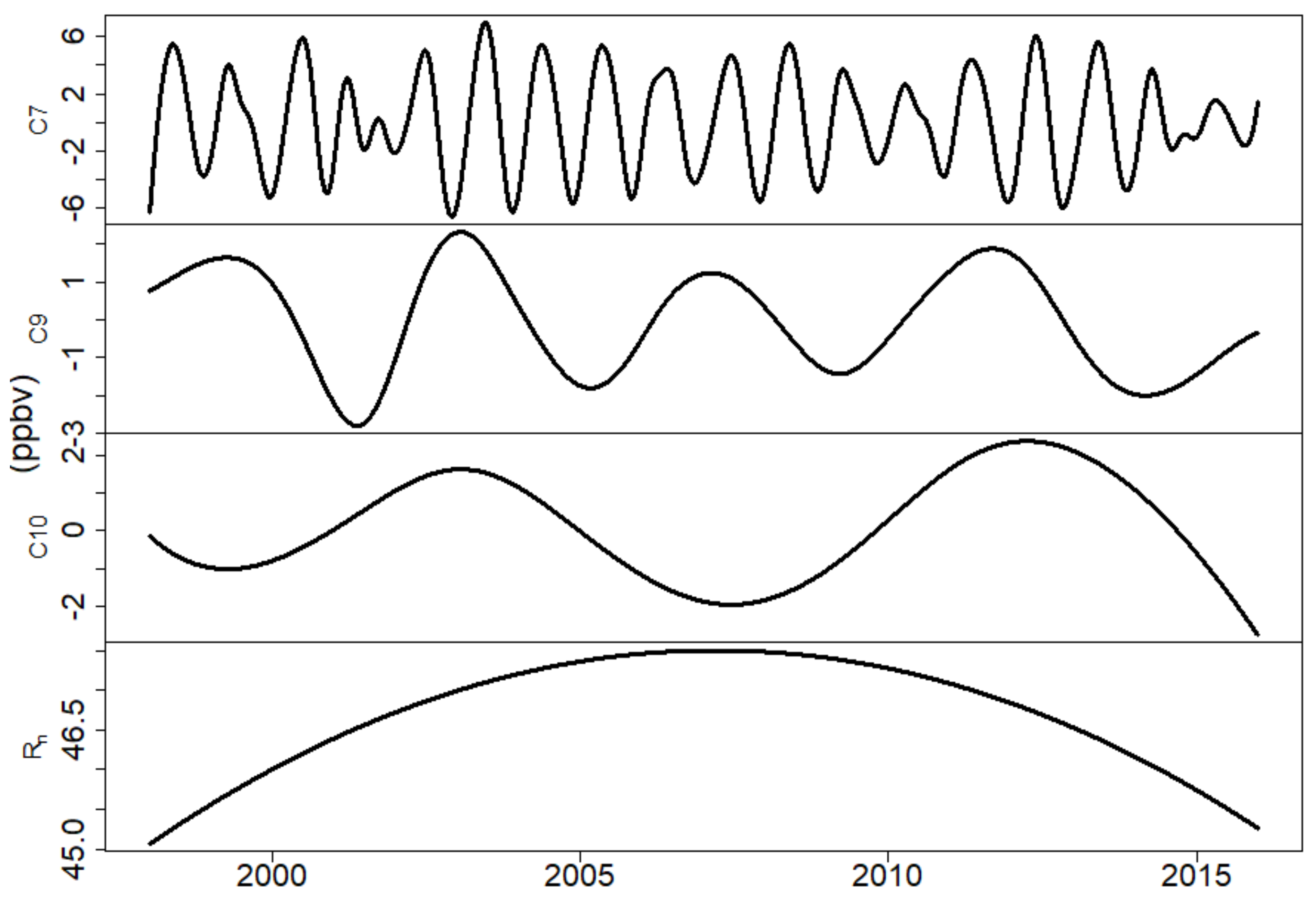

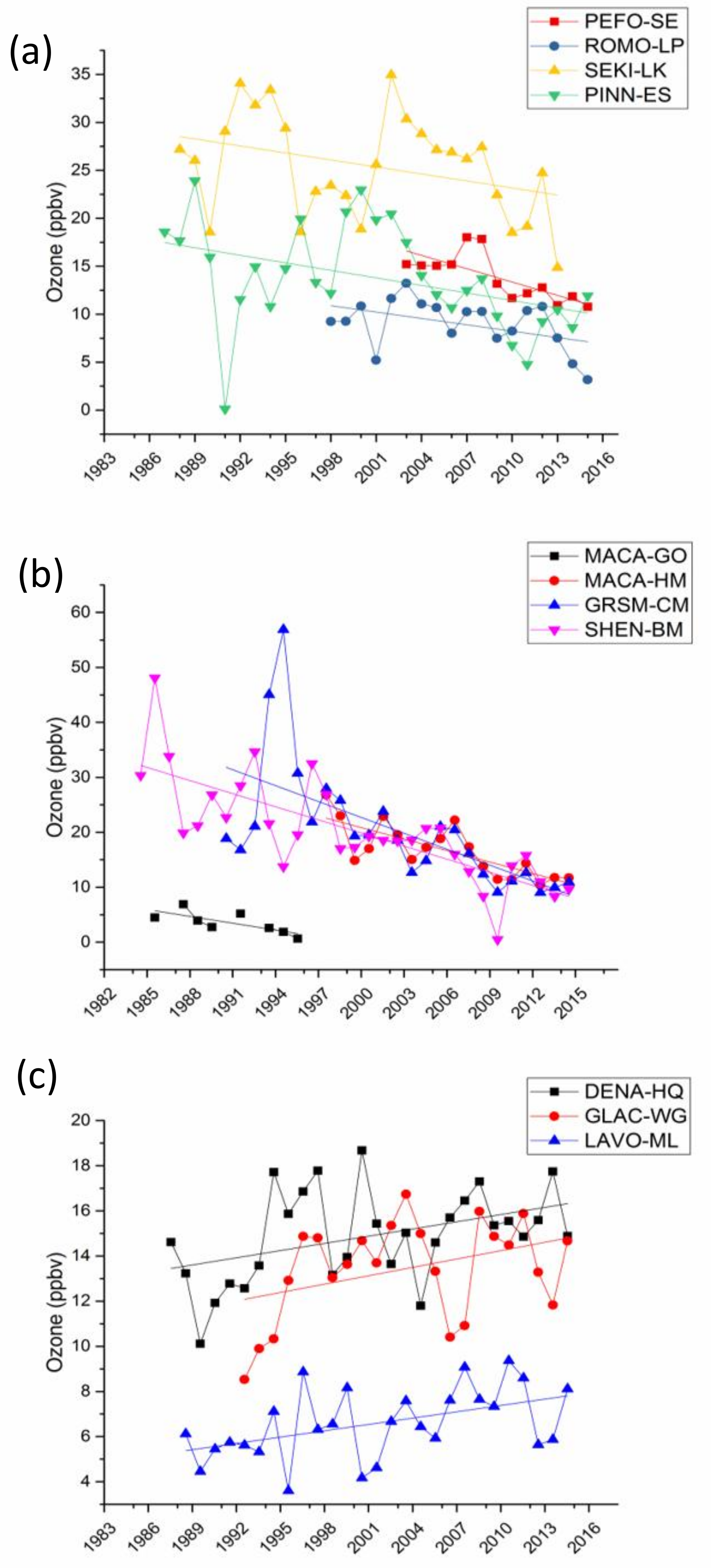
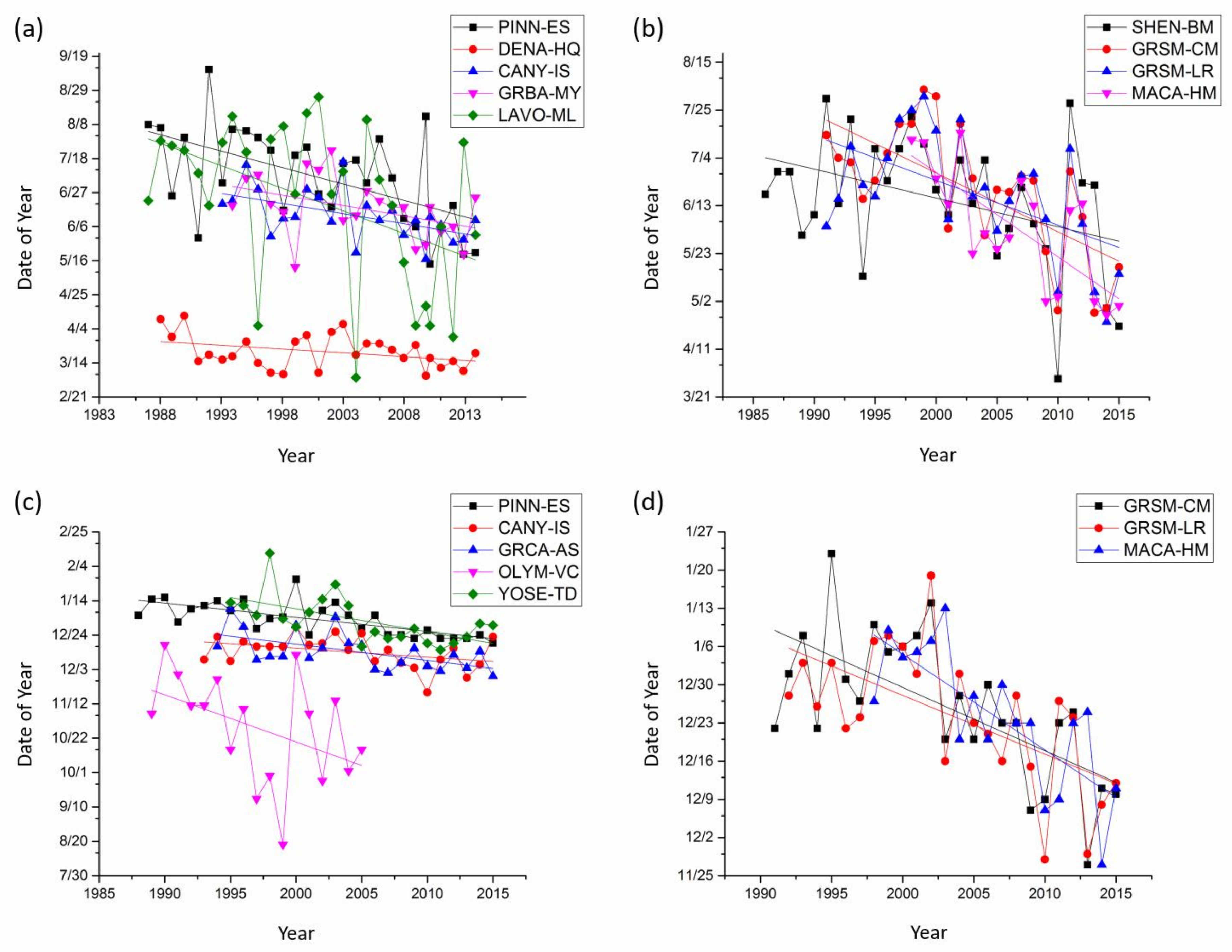


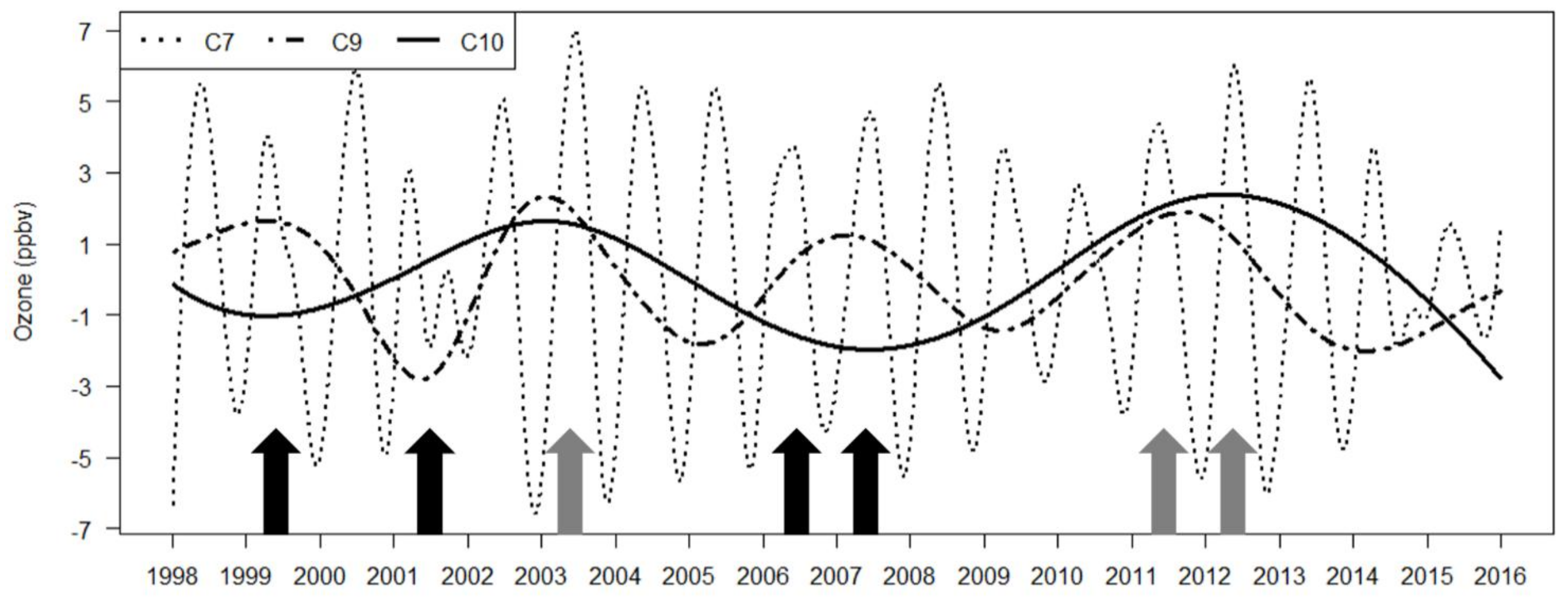
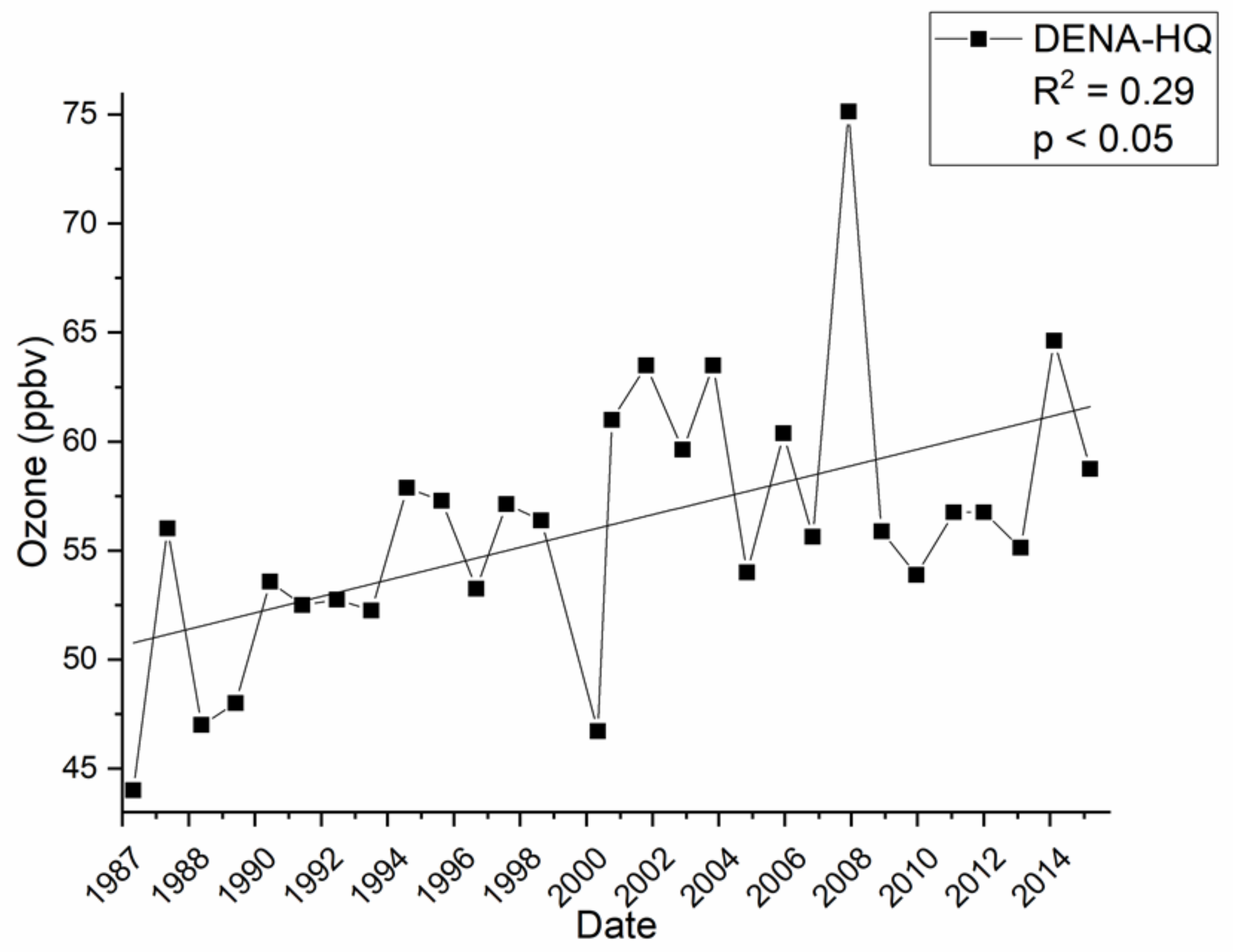


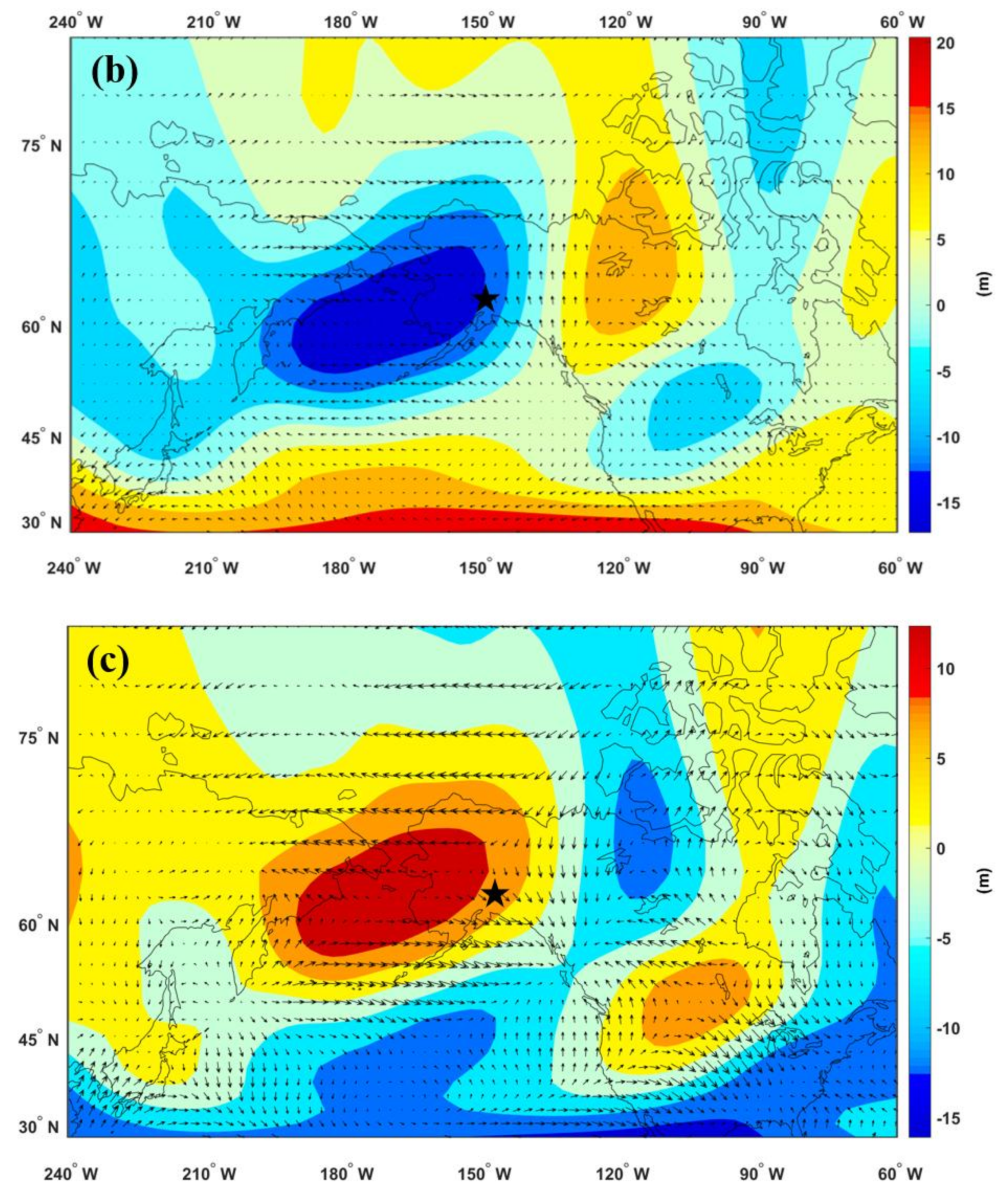
| State | ABBR | National Park | Site | North Lat. | West Long. | Start Date | End Date | Elevation(m) |
|---|---|---|---|---|---|---|---|---|
| Northwest | ||||||||
| AK | DENA-HQ | Denali | Headquarters | 63.7258 | 148.9633 | 7/1/1987 | 661 | |
| WA | MORA-TW | Mount Rainier | Tahoma Woods | 46.7583 | 122.1244 | 7/1/1991 | 10/1/2013 | 415 |
| WA | NOCA-MM | North Cascades | Marblemount Ranger Stn. | 48.5397 | 121.4472 | 2/1/1996 | 1/31/2008 | 109 |
| WA | OLYM-VC | Olympic | Visitor Center | 47.7372 | 123.1653 | 8/1/1985 | 2/28/2005 | 427 |
| West | ||||||||
| CA | DEVA-PV | Death Valley | Park Village | 36.5092 | 116.8481 | 12/1/1993 | 125 | |
| CA | LAVO-ML | Lassen Volcanic | Manzanita Lake Fire Stn. | 40.5403 | 121.5764 | 10/1/1987 | 1756 | |
| CA | PINN-ES | Pinnacles | SW of East Entrance Stn. | 36.485 | 121.1556 | 4/1/1987 | 335 | |
| CA | SEKI-LK | Sequoia & Kings Canyon | Lower Kaweah | 36.5658 | 118.7772 | 6/1/1984 | 1890 | |
| CA | YOSE-TD | Yosemite | Turtleback Dome | 37.7133 | 119.7061 | 1/1/1992 | 3037 | |
| Intermountain West | ||||||||
| TX | BIBE-KB | Big Bend | K-Bar Ranch Road | 29.3022 | 103.1772 | 9/15/1990 | 1052 | |
| UT | CANY-IS | Canyonlands | Island in the Sky | 38.4586 | 109.8211 | 7/1/1992 | 1809 | |
| MT | GLAC-WG | Glacier | West Glacier Horse Stbls | 48.5103 | 113.9956 | 1/1/1992 | 976 | |
| NV | GRBA-MY | Great Basin | Maintenance Yard | 39.0053 | 114.2158 | 8/24/1993 | 2060 | |
| AZ | GRCA-AS | Grand Canyon | The Abyss | 36.0597 | 112.1822 | 1/1/1993 | 2073 | |
| CO | MEVE-RM | Mesa Verde | Resource Mngment Area | 37.1983 | 108.4903 | 3/1/1993 | 2165 | |
| AZ | PEFO-SE | Petrified Forest | South Entrance | 34.8225 | 109.8919 | 1/1/2002 | 1723 | |
| CO | ROMO-LP | Rocky Mountain | Long's Peak | 40.2778 | 105.5453 | 1/5/1998 | 28 | |
| WY | YELL-WT | Yellowstone | Water Tank | 44.5597 | 110.4006 | 6/1/1996 | 2400 | |
| UT | ZION-DW | Zion | Dalton's Wash | 37.1983 | 113.1506 | 1/1/2004 | 1213 | |
| East | ||||||||
| NC | GRSM-CM | Great Smoky Mountains | Cove Mountain | 35.6967 | 83.6086 | 7/1/1988 | 1243 | |
| NC | GRSM-LR | Great Smoky Mountains | Look Rock | 35.6331 | 83.9422 | 7/1/1988 | 793 | |
| KY | MACA-GO | Mammoth Cave | Great Onyx Meadow | 37.2178 | 86.0736 | 12/1/1984 | 7/31/1997 | 219 |
| KY | MACA-HM | Mammoth Cave | Houchin Meadow | 37.1317 | 86.1481 | 7/1/1997 | 258 | |
| VA | SHEN-BM | Shenandoah | Big Meadows | 38.5231 | 78.4347 | 5/1/1983 | 1072 | |
| MN | VOYA-SB | Voyageurs | Sullivan Bay | 48.4128 | 92.8292 | 6/1/1996 | 429 | |
| Site | Trend (ppbv yr−1) | Year of trend changes | Trends (ppbv yr−1) |
|---|---|---|---|
| Northwest | |||
| DENA-HQ | 0.04 ± 0.02 | 1/8/2006 | −0.02 ± 0.01 |
| MORA-TW | 0.27 ± 0.15 | 7/20/2002 | −0.32 ± 0.18 |
| NOCA-MM | 0.16 ± 0.10 | 7/21/2001 | −0.20 ± 0.11 |
| OLYM-VC | 0.25 ± 0.15 | 1/13/1998 | −0.08 ± 0.05 |
| West | |||
| DEVA-PV | 0.23 ± 0.13 | 1/13/2007 | −0.18 ± 0.10 |
| LAVO-ML | 0.23 ± 0.13 | 10/17/2007 | −0.10 ± 0.06 |
| PINN-ES | - | - | −0.34 ± 0.10 |
| SEKI-LK | 0.08 ± 0.04 | 4/16/1997 | −0.12 ± 0.07 |
| YOSE-TD | 0.07 ± 0.04 | 10/19/1998 | −0.26 ± 0.15 |
| Intermountain West | |||
| BIBE-KB | 0.11 ± 0.01 | - | - |
| CANY-IS | 0.001 ± 0.001 | 2/10/2001 | −0.08 ± 0.04 |
| GLAC-WG | 0.18 ± 0.02 | - | - |
| GRBA-MY | 0.28 ± 0.16 | 9/16/2006 | −0.20 ± 0.11 |
| GRCA-AS | 0.37 ± 0.21 | 9/28/2006 | −0.25 ± 0.14 |
| MEVE-RM | 0.40 ± 0.23 | 8/15/2007 | −0.24 ± 0.14 |
| PEFO-SE | 0.03 ± 0.02 | 3/21/2004 | −0.23 ± 0.13 |
| ROMO-LP | 0.29 ± 0.18 | 3/6/2009 | −0.25 ± 0.13 |
| YELL-WT | 0.19 ± 0.11 | 10/23/2006 | −0.17 ± 0.10 |
| ZION-DW | 0.44 ± 0.26 | 12/16/2008 | −0.63 ± 0.37 |
| East | |||
| GRSM-CM | 0.07 ± 0.04 | 1/18/1995 | −0.35 ± 0.20 |
| GRSM-LR | 0.35 ± 0.20 | 7/18/2003 | −0.35 ± 0.20 |
| MACA-GO* | 0.09 ± 0.01 | - | - |
| MACA-HM* | - | - | −0.60 ± 0.01 |
| SHEN-BM | 0.37 ± 0.21 | 10/27/2002 | −0.27 ± 0.16 |
| VOYA-SB | 0.26 ± 0.15 | 10/21/2003 | −0.44 ± 0.25 |
© 2018 by the authors. Licensee MDPI, Basel, Switzerland. This article is an open access article distributed under the terms and conditions of the Creative Commons Attribution (CC BY) license (http://creativecommons.org/licenses/by/4.0/).
Share and Cite
McGlynn, D.; Mao, H.; Wu, Z.; Sive, B.; Sharac, T. Understanding Long-Term Variations in Surface Ozone in United States (U.S.) National Parks. Atmosphere 2018, 9, 125. https://doi.org/10.3390/atmos9040125
McGlynn D, Mao H, Wu Z, Sive B, Sharac T. Understanding Long-Term Variations in Surface Ozone in United States (U.S.) National Parks. Atmosphere. 2018; 9(4):125. https://doi.org/10.3390/atmos9040125
Chicago/Turabian StyleMcGlynn, Deborah, Huiting Mao, Zhaohua Wu, Barkley Sive, and Timothy Sharac. 2018. "Understanding Long-Term Variations in Surface Ozone in United States (U.S.) National Parks" Atmosphere 9, no. 4: 125. https://doi.org/10.3390/atmos9040125





